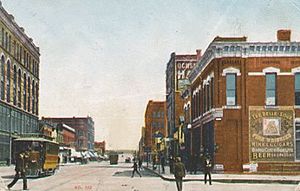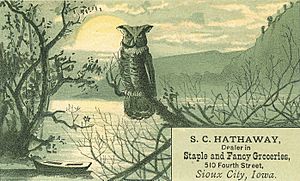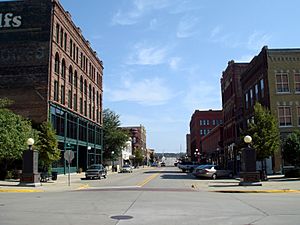History of Sioux City, Iowa facts for kids
Iowa is a state in the central United States, known for its wide-open tallgrass prairie lands. Long ago, people who spoke Siouan languages lived here.
The area around what is now Sioux City, Iowa was home to the Yankton Sioux tribe. In the 1700s, Spanish and French fur trappers were the first Europeans to arrive.
In 1803, France sold a huge part of North America to the United States of America in a deal called the "Louisiana Purchase". Most of this land had not been explored by white settlers. President Thomas Jefferson sent the Corps of Discovery, led by Lewis and Clark, to map and study the new territory.
In 1804, the Lewis and Clark expedition traveled up the Missouri River. They camped near where Sioux City is today. On August 20, a member of the expedition, Sgt. Charles Floyd, became sick and died. He was buried on a bluff overlooking the river. At that time, the Omaha tribe lived downstream, and the Yankton Sioux lived upstream from this area.
In 1848, William Thompson set up a trading post near Floyd's Bluff. He hoped to start a city there, but his plans didn't work out. Other settlers, further upriver between the Floyd and Big Sioux rivers, had more success.
Contents
Founding Sioux City
Theophile Bruguier, a French-Canadian fur trader, is thought to be the first white settler in the area that became Sioux City. He had traveled through this spot many times on his trips between Fort Pierre and St. Louis, Missouri.
In 1849, Bruguier started his farm on this land. His farm included log cabins and tipis used by the family of Chief War Eagle of the Yankton Sioux. Bruguier claimed all the land from the mouth of the Big Sioux River east along the Missouri River to near the Floyd River.
In 1852, Bruguier sold some of his land to Joseph Leonais. Around that time, Bruguier encouraged James A. Jackson, a fur trade supplier, to come upriver and start a trading post. Jackson then convinced his father-in-law, Dr. John K. Cook, that the area was a good spot for a future city.
Dr. Cook, who was a U.S. Federal Government surveyor, was very impressed by the location where the Big Sioux and Floyd Rivers met the Missouri. In 1854, Dr. Cook officially laid out the town of Sioux City, marking its lots and streets. Joseph Leonais, who owned much of the land that would become downtown, sold it to Dr. Cook for $3000. Within three years, the new town had 400 people and became an official city.
Sioux City in the 1800s
The first steamboat arrived from St. Louis in June 1856. It brought ready-made houses and supplies.
The railroad first reached Sioux City in 1868. Around this time, a few small factories opened. In 1873, James Booge opened the first large meatpacking plant. This created a need for livestock, which led to the opening of the stockyards in 1884.
The years from 1880 to 1890 were a time of very fast growth for Sioux City.
- In 1880, the population was 7,500.
- By 1890, it had grown to 38,700.
Street cars, water systems, electric lights, and other improvements appeared. More factories, meatpacking plants, stores, and railroads came to the city. Sioux City even built an elevated railroad and some early "skyscrapers." These changes showed how small pioneer towns were growing into busy cities across the country. President Grover Cleveland visited in 1887. By then, Fourth Street was the main business area.
Sioux City is also where the Corn Palace started. This was a temporary building made each year for the Corn Festival. The Sioux City Corn Palaces were large wooden buildings with corn cobs nailed to their walls. The first one was built in 1887. The Corn Palace grew bigger and grander each year. The last Sioux City Corn Palace, built in 1891, was huge and covered part of the downtown area. It had three towers, one of which was 200 feet tall. It also had a large tunnel for traffic to pass underneath.
However, bad weather meant fewer people came to the 1891 Corn Festival. Then, the Great Floyd River Flood of 1892 ended any hopes for future festivals, and Corn Palaces were never built in Sioux City again.
In May 1892, heavy rains caused the Floyd River to flood. A destructive wave of muddy water rushed through the city. At least three thousand people lost their homes. The stockyards and railroad lines were badly damaged, and a lumber yard caught fire. Twenty-five people died in the flood.
The nationwide economic troubles of 1893 caused many real estate investors in Sioux City to lose a lot of money.
In 1898, units of the Iowa National Guard were called to active duty for the War with Spain. The 51st Regiment was sent to the Philippines and fought there.
Sioux City in the 1900s
At the start of the 1900s, Sioux City had a population of 33,000.
Early 1900s (1900-1910)
Floyd Monument
In 1900, construction began on the 100-foot-tall Floyd Monument. This stone monument stands on a high bluff overlooking the Missouri River. It honors the burial site of Sgt. Charles Floyd, who died near here during the Lewis and Clark journey in 1804. The monument was finished in 1901. In 1960, the U.S. Department of Interior recognized it as the First National Historic Landmark.
Pelletier Store Fire
On December 23, 1904, a big fire broke out in the basement of the Pelletier Department Store. A store employee lit a match near a Christmas toy display, and the match head fell into cotton used to look like snow. The fire quickly spread through the building and to nearby buildings. Two and a half blocks of the downtown area were destroyed. Only one person died, but the property loss was millions of dollars. Sioux City businesses quickly rebuilt the downtown area.
1910s (1911-1920)
Free Speech Efforts
In the winter of 1914, the Industrial Workers of the World (IWW) came to Sioux City to organize workers. They wanted to create a big union for industrial and farm laborers to get better wages and shorter hours. Many unemployed men came to the city. The main activity was on Fourth Street, where police and National Guardsmen clashed with the workers. Hundreds of laborers were arrested.
First World War
When the United States entered World War I in April 1917, many Sioux City men joined the military. The 3rd Iowa National Guard Regiment became the 168th Infantry Regiment and was part of the 42nd "Rainbow" Division. This was the first American combat division to reach the front lines in France in February 1918. Many members of Company L were from Sioux City.
Other Sioux City National Guardsmen joined the 133rd Infantry Regiment. After training, they were sent to France in 1918. Many of these soldiers were later sent as replacements to the 168th Infantry, fighting in the final battles of the war. After the war ended in November 1918, some Sioux City soldiers stayed in Germany until May 1919 before returning home.
In 1919, over 1400 Sioux City veterans formed Monahan Post No. 64 of the American Legion. It was named after Private Edward Monahan of Sioux City, the first man from the 168th Infantry Regiment killed in action in France. He was honored with the French Croix de Guerre Medal.
In 1921, Sioux City created the "Memorial Mile" on Stone Park Boulevard. They planted a tree for every Sioux City serviceman killed in the war.
Mayor Wallace M. Short (1918-1923)
Wallace Mertin Short, a highly educated minister, became Mayor of Sioux City. He was known for supporting the rights of working people and ethnic minorities. He believed strongly in the U.S. Constitution and the Bill of Rights. Short served three terms as Mayor, from 1918 to 1923.
Ruff Building Collapse
On June 29, 1918, Sioux City experienced a terrible accident when the four-story Ruff Pharmaceutical building collapsed. Workers were renovating the upper floors while stores on the ground level were still open. The building suddenly fell, trapping many people. Gas pipes broke, causing a large fire that burned for 36 hours. Thirty-nine people died in what was called "the Ruff Disaster."
Mid-1900s (1921-1960)
By 1920, Sioux City's population grew to 71,227. In the early 1930s, farmers went on strike to protest low prices for their crops.
World War Two
As World War II approached, Sioux City's National Guard units were called to active duty in 1941. Companies L, M, and the Howitzer Company of the 133rd Iowa Infantry Regiment were among the first Americans sent to Europe. They landed in Northern Ireland and later fought in North Africa and Italy.
Air Base
During World War II, the U.S. Army built a large training base at Sergeant Bluff, Iowa, about 8 miles south of downtown Sioux City. It had big runways for heavy bombers. The Sioux City Army Air Base became a main place for training on B-17 bombers. Hollywood actor and pilot Jimmy Stewart was stationed here in 1943 to complete his B-17 training. After the war, in 1946, the 185th Iowa Air National Guard unit was established in Sioux City.
Swift Packing Plant Explosion
On December 14, 1949, the large Swift & Company packing house exploded, killing 21 employees. The cause was believed to be a gas leak.
By 1950, Sioux City had a population of about 84,000.
Missouri River Flood (1952)
In the spring of 1952, the Missouri River flooded, covering downtown Sioux City and many nearby towns. After this flood, many cases of a serious illness were reported in the area until a vaccine was developed in the late 1950s.
Floyd River Flood (1953)
On June 8, 1953, the Floyd River flooded again after heavy rain. A wall of water rushed down the valley, and fourteen people died. This flood led to a major flood control project on the Floyd River. This project included building a straightened, rock-lined channel and high levee through the city. The "South Bottoms" neighborhood, which often flooded, was cleared for this project in 1962.
Late 1900s (1961-2000)
All America City
In 1962, Sioux City was named an All America City by the National Civic League.
River Cade
In 1964, the Sioux City Chamber and other groups started River Cade, a week-long summer celebration of Sioux City's history. This event is still held along the Missouri Riverfront each year, with a parade, carnival, boat races, and other activities.
Vietnam War
In 1967, during the Vietnam War, the U.S Naval Reserve Construction Battalion (SEABEEs) from Sioux City was called to active duty. They were sent to Danang, South Vietnam, to build bases for the Navy and Marine Corps. They served bravely and returned home with honor.
In 1968, the 185th Tactical Fighter Squadron, Iowa Air National Guard, from Sioux City, was also sent to Vietnam. They served with distinction in combat. Also in 1968, some Sioux City National Guard members were sent to Fort Carson, Colorado, and later to South Korea or as replacement troops to Vietnam. At least three Sioux City Guard members were killed in action in Vietnam.
Downtown Changes
The 1970s saw a period of urban renewal in downtown Sioux City. Many old buildings, some from the 1800s, were torn down to rebuild the area.
The meatpacking industry, which had been very important to Sioux City, changed a lot. New ways of processing meat and combining job tasks meant that the industry started to shrink within Sioux City's borders. This led to the decline of the Sioux City Stockyards. Newer, "cleaner" industries, like computer manufacturing, began to take its place. These changes transformed Sioux City into a cleaner city.
F4 Tornado
On July 28, 1986, a powerful F4 tornado hit areas just west and south of Sioux City. It destroyed one of the power plants at Port Neal. No one was killed, and the tornado avoided crowded areas.
Flight 232 Airline Crash
On July 19, 1989, United Airlines Flight 232, a Douglas DC-10 plane, crashed at the Sioux Gateway Airport. Tragically, 111 people died, but 185 on board survived thanks to the efforts of the pilot and crew. The airport had a full-time Air National Guard base, and about 200 air guardsmen helped search for survivors in the cornfields around the plane. The city's recent disaster training also helped. This event was made into a TV movie in 1991.
All America City Again
In 1990, because of its rescue efforts and the kindness of its citizens during the Flight 232 disaster, Sioux City was again named an All America City by the National Civic League.
Terra International Explosion
On December 13, 1994, an explosion at the Terra International plant killed four people and injured 18. The explosion released a dangerous cloud into the air and leaked nitric acid into the ground. People in nearby areas had to evacuate.
Sioux City in the 21st Century
In the 2000s, much of the downtown area's impact was lost due to suburban development, including the Southern Hills Mall. Some department stores moved from downtown to the mall. The Sioux City Public Museum is renovating a new building to move from its smaller historic location.
However, downtown Sioux City has also seen new development. The Orpheum Theatre was restored after being used as a movie theater since the 1960s. The Tyson Events Center opened in 2003, replacing the old Sioux City Municipal Auditorium. In 2004, a new movie theater opened downtown.
In 2005, Sioux City was recognized as one of Iowa's "Great Places." A major addition in the 2010s was the Hard Rock Hotel and Casino, which brings many big acts and is a main attraction in the Sioux City area today.





